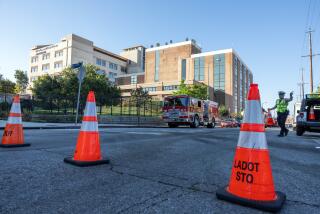Doctors, wash your hands
- Share via
THE CALIFORNIA health department’s recent finding about what caused an outbreak of infection at White Memorial Medical Center is almost as disturbing as the outbreak itself. Last December, seven children, including five infants so fragile they needed neonatal intensive care, contracted pseudomonas aeruginosa. Two of the infants died. The Boyle Heights hospital had failed to sterilize equipment used to help the children breathe, though the manufacturer specified that sterilization was necessary.
The saddest thing about this story, however, is how often it happens.
Every day in hospitals across the United States, wondrous medical procedures rescue patients from the brink of death. But there’s a catch: In these same hospitals, hygiene is so inadequate that one out of every 20 patients contracts an infection. Why? Because of dirty hands, inadequately cleaned equipment, unclean rooms and lax procedures.
Astoundingly, over half the time, physicians and other caregivers break the most fundamental rule of hygiene by failing to clean their hands before treating patients, according to the Centers for Disease Control and Prevention. Caregivers often think putting on gloves -- without cleaning their hands first -- is sufficient, but this simply contaminates the gloves.
Cleaning hands, while essential, is only the first step. Stand in an emergency room and watch caregivers clean their hands, put on gloves and then reach up and pull open the privacy curtain to see the next patient. That curtain is seldom changed and is often covered in bacteria. The result? Caregivers’ hands are soiled before reaching the patient.
Research shows that nearly three-quarters of patients’ rooms are contaminated with dangerous bacteria, including the dreaded methicillin-resistant staphylococcus aureus. These bacteria are on cabinets, counter tops, bedrails, bedside tables, IV poles and on the floor under the bed. Once patients or caregivers touch these surfaces, their hands carry disease-causing bacteria to other patients.
Stethoscopes, blood-pressure cuffs, pulse oximeters and other equipment spread bacteria. Doctors and nurses rarely clean stethoscopes before listening to patients’ chests, though the American Medical Assn. recommends it. When the inflatable blood-pressure cuff is wrapped around a patient’s bare arm, is it cleaned first? Virtually never, though a recent study in the journal Infection Control and Hospital Epidemiology indicated that 77% of blood- pressure cuffs were contaminated.
Too many hospitals practice first-class medicine but third-rate hygiene. Rigorous adherence to hand hygiene and sterile procedures can almost eradicate many types of infections. At Allegheny Hospital in Pittsburgh, Dr. Richard Shannon noticed that many patients who had central line devices to deliver medication into a major artery were developing deadly bloodstream infections. He led an effort there for rigorous hand hygiene, meticulous attention to sterile precautions and cleanliness in the area around the device. The result? He and his team reduced central line-associated bloodstream infections 90% in 90 days.
In Michigan, 106 intensive care units have taken almost identical steps and reduced device-related infections by two-thirds, according to the New England Journal of Medicine. We have the knowledge to prevent hospital infections. What has been lacking is the will.
Secrecy is largely to blame. Until recently, hospitals did not have to make their infection rates public. Fortunately, more than two dozen states, including Florida, New York and Pennsylvania, have passed laws requiring hospital infection report cards. If you have to be hospitalized, you should be able to find out which hospital in your area has the worst infection rate so you can stay away.
Unfortunately, Californians cannot get that information. The California Legislature has enacted a law -- SB 739 -- that only requires reporting of which hospitals follow certain procedures deemed relevant to preventing infections. That may be helpful, but Californians should be able to get more.
Can hospitals afford to improve hygiene and provide better training for caregivers? They can’t afford not to. Patients who contract infections have to stay in the hospital days or weeks longer and sometimes go through repeated operations to cut out infected tissue. Hospitals don’t get paid fully for the extra time, treatment or medication (nor should they). Hospital infections add more than $30.5 billion a year to the nation’s health tab in hospital costs alone. That’s about $3 billion in California.
To get a sense of the tragedy of unsound hospital hygiene, compare it with an issue that gets far more attention -- lack of health insurance coverage. The Institute of Medicine estimates that as many as 18,000 Americans a year die prematurely because they don’t have health insurance. Five times that many die each year from hospital infections. Most of these people are insured. And some are very young. Just ask the parents who lost children at White Memorial.





